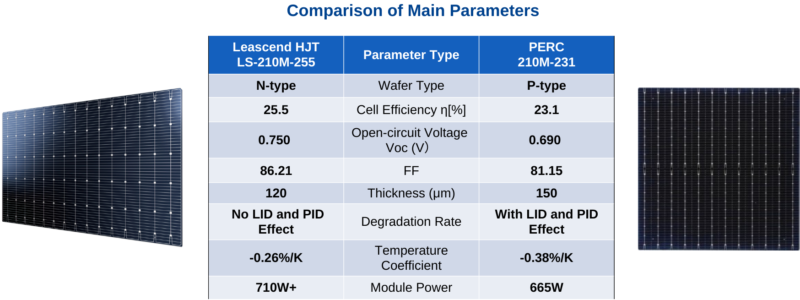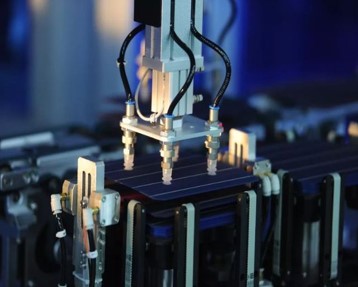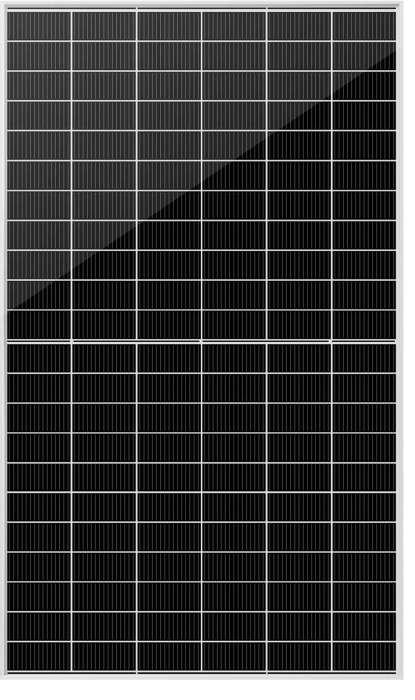HJT Technology - Introduction
The acronym HJT refers to heterojunction solar cells, which were originally developed by the Japanese company Sanyo in the 1980s. In recent years, Panasonic has acquired this technology through acquisition. In comparison to alternate solar cells such as PERC, HJT exhibits a simpler manufacturing process, where thermal processes are not extensively required. Additionally, HJT technology offers notable cost advantages, as it requires relatively fewer steps in its fabrication processes, minimizing processing costs, thus making it a highly favorable alternative to existing solar cell technology.

Construction HJT Cells
Heterojunction (HJT) tech is a combo of wafer-based solar cells & thin-film photovoltaic cells. It makes solar cells stronger & better at producing energy. HJT tech is attractive because it’s good at absorbing sunlight & protecting the cells. It can be used with other types of silicon wafers but is usually used with n-type silicon wafers. Using HJT tech can make solar panels better quality & more efficient, which helps with the energy crisis.

HJT, which stands for Heterojunction with Intrinsic Thin Layer, is a type of solar cell technology that combines the advantages of both crystalline silicon and thin-film solar cells. It is known for its high efficiency and low temperature coefficient, making it an attractive option for solar energy conversion.
Here is a general overview of the construction of an HJT solar cell:
Substrate: The solar cell construction starts with a substrate, which is typically made of crystalline silicon. The substrate provides structural support and acts as a foundation for the subsequent layers.
N-Type Layer: A thin layer of n-type (negative-type) amorphous silicon is deposited on the substrate. This layer serves as the emitter of the solar cell, allowing the flow of electrons.
Intrinsic Layer: Next, an intrinsic (undoped) amorphous silicon layer is added on top of the n-type layer. This intrinsic layer is responsible for absorbing photons from sunlight and generating electron-hole pairs.
P-Type Layer: On top of the intrinsic layer, a thin layer of p-type (positive-type) amorphous silicon is deposited. This layer acts as the back surface field (BSF) and facilitates the collection of holes.
Transparent Conductive Oxide (TCO) Layer: A transparent conductive oxide layer, such as indium tin oxide (ITO) or fluorine-doped tin oxide (FTO), is added to the p-type layer. This layer allows light to pass through while providing a conductive path for the generated charge carriers.
Front Metal Contacts: Metal contacts, typically made of silver or aluminum, are placed on the TCO layer to collect the electrons generated by sunlight. These contacts allow for the extraction of electrical current from the solar cell.
Back Metal Contacts: Similarly, metal contacts are placed on the backside of the substrate to collect the holes generated by sunlight. These contacts complete the circuit and enable the flow of current.
It’s worth noting that the construction process can vary among HJT cells manufacturers, and additional layers or modifications may be present in specific designs. However, the basic principle of combining p-n junctions and thin-film materials to achieve high-efficiency solar cells remains the same in HJT technology.
Differences between HJT and N-Type / PERC
Compared to the standard crystalline solar cells like PERC and N-Type, heterojunction cells are made by combining two different materials. While the former has homogeneous layers, heterojunction cells have an enriched crystalline silicon substrate and an amorphous silicon layer of opposite conductivity. The bond is made between crystalline and amorphous silicon materials for HJT silicon. The use of heterojunction cells provides better efficiency, more stable performance and higher power output while being cost-effective. Hence, it is a promising cell technology for the future solar industry due to their unique benefits.

Heterojunction (HJT) cells and PERC (Passivated Emitter and Rear Cell) cells are two different types of solar cell technologies. Here are the main differences between HJT cells (specifically n-type HJT) and PERC cells:
Cell Structure: HJT cells, including n-type HJT, have a layered structure with both the front and rear sides of the cell having contacts. This allows for efficient charge carrier collection. PERC cells, on the other hand, have a rear-side passivation layer that reduces recombination and improves charge carrier collection.
Doping Type: HJT cells, including n-type HJT, use both n-type and p-type materials. The n-type material is typically a thin amorphous silicon layer. PERC cells, on the other hand, use only a single doping type, which is typically p-type.
Carrier Selective Contacts: HJT cells utilize carrier-selective contacts on both the front and rear sides of the cell. These contacts help to separate and collect the positive and negative charge carriers efficiently. PERC cells, on the other hand, have a rear-side passivation layer that reduces recombination, but they typically do not have selective contacts on both sides.
Efficiency: HJT cells, including n-type HJT, generally offer higher conversion efficiencies compared to PERC cells. HJT technology has demonstrated higher efficiency levels due to reduced losses from recombination and better charge carrier collection.
Manufacturing Process: HJT cells, including n-type HJT, require additional steps in the manufacturing process compared to PERC cells. HJT cells involve the deposition of amorphous silicon layers and patterning of contacts on both the front and rear sides. PERC cells involve a simpler process with the addition of a passivation layer on the rear side.
Market Adoption: PERC technology has been widely adopted by the solar industry and is currently the dominant technology for commercial solar cells. HJT technology, including n-type HJT, is considered an advanced technology with higher efficiency potential, but it is not as widely implemented in the market.
Panels HJT Construction
The field of photovoltaics has been revolutionized by the pioneering work in Heterojunction (HJT) technology by Sanyo, a famous innovator in this field. The patented “Heterojunction Sanyo” proposed a novel approach to constructing panels, with an intrinsic thin layer between enriched surfaces of amorphous and crystalline silicon. To ensure practicality, this approach incorporates a crystalline silicon wafer, n-type in most cases, which is sandwiched between inner layers of amorphous silicon with opposite enrichment. These layers are deposited on both sides, followed by the placement of a transparent conductive oxide (TCO) on the top. It is noteworthy that most existing HJT concepts are based on this template, which has proven to be reliable and effective in enhancing the efficiency of photovoltaic systems.
HJT (Heterojunction) solar panels have a specific construction that involves several main parts. Here are the key components typically found in HJT solar panels:
Photovoltaic Cells: The core component of an HJT solar panel is the photovoltaic cells themselves. HJT cells are made up of multiple layers of different materials, including both n-type and p-type semiconductors, such as amorphous silicon and crystalline silicon. These layers work together to convert sunlight into electricity.
Front Transparent Conductive Layer: The front side of the HJT cell has a transparent conductive layer that allows sunlight to pass through to the cell while providing a conductive path for the generated electricity.
Anti-Reflection Coating: To enhance light absorption, reduce reflection, and increase overall efficiency, HJT panels often include an anti-reflection coating on the front surface. This coating helps to minimize light reflection and maximize the amount of light that reaches the cell.
Back Passivation Layer: The back side of the HJT cell typically has a passivation layer. This layer helps to reduce recombination of charge carriers, improving the cell’s overall efficiency. The passivation layer can be made of materials like amorphous silicon dioxide (SiO2) or other materials that provide excellent surface passivation properties.
Electrical Contacts: HJT cells have contacts on both the front and back sides to collect the electricity generated by the cell. These contacts are usually made of metal grids or thin conductive strips that allow the electrical current to be extracted from the cell.
Encapsulation: HJT panels are typically encapsulated to protect the cells from environmental factors such as moisture, dust, and mechanical stress. Encapsulation is usually done with layers of encapsulant material (such as ethylene-vinyl acetate or EVA) and a protective backsheet.
Frame and Mounting: HJT panels are often equipped with a frame, typically made of aluminum or other durable materials, to provide structural support and protect the panel. The frame may also include mounting holes or brackets for easy installation onto rooftops or mounting systems.
These are the main parts typically found in HJT solar panels. It’s worth noting that the exact construction and components used may vary among manufacturers, but the overall principle and functionality remain similar.
HJT Cells Efficiency
HJT (Heterojunction) solar cells are known for their high conversion efficiencies compared to traditional crystalline silicon solar cells. The efficiency of HJT cells can vary depending on several factors, including the manufacturing process, materials used, and specific design optimizations. However, HJT cells have demonstrated the potential to achieve high efficiencies.
Commercially available HJT solar cells have reported efficiencies exceeding 25% e.g. cells from LPV HJT (Liansheng) with 25,5%. In laboratory settings and research environments, even higher efficiencies have been achieved, with some research cells reaching efficiencies above 26% and even approaching 27%.
It’s important to note that these reported efficiencies represent the best performance achieved in specific research or manufacturing settings. The actual efficiency of commercially available HJT panels may vary and can be affected by factors such as cell size, module design, and environmental conditions.
Overall, HJT technology has shown promise in achieving high efficiencies and continues to undergo research and development efforts to further improve performance. However, it’s always advisable to consult with specific manufacturers or suppliers to obtain the most up-to-date information on the efficiency of HJT solar panels that are available in the market.

HJT power hjt solar panel 700W for utility scale investment
Investing in high-power HJT (Heterojunction with Intrinsic Thin-layer) solar panels with a 700W capacity for utility-scale projects can offer several advantages, making them a potentially strong choice. Here are some reasons why they might be considered the best choice:
Higher Efficiency: HJT solar panels are known for their higher conversion efficiency compared to traditional solar panels. They utilize a combination of crystalline silicon and thin-film technology, reducing losses from recombination and enabling them to convert a higher percentage of sunlight into electricity. This increased efficiency means that you can generate more electricity per unit area, maximizing the energy production of your utility-scale solar project.
Enhanced Performance in High Temperatures: HJT panels are generally less affected by temperature-related losses compared to traditional solar panels. They can maintain a more stable and efficient performance even in high-temperature environments, which is crucial for utility-scale installations in sun-drenched regions.
Improved Low-Light Performance: HJT panels have demonstrated better performance in low-light conditions, such as cloudy or overcast weather. This characteristic is particularly beneficial for utility-scale projects, as it ensures a more consistent and reliable energy production throughout the year, regardless of weather fluctuations.
Longevity and Durability: HJT solar panels are typically designed to be durable and have a long lifespan. Reputable manufacturers often offer extended product warranties, ensuring that the panels can withstand harsh environmental conditions and continue to perform optimally over time. This durability is particularly important for utility-scale projects where long-term reliability is a key factor in financial returns.
High Power Output: With a 700W capacity, high-power HJT panels provide a significant amount of electricity generation potential per individual panel. This can help reduce the total number of panels needed for a utility-scale installation, reducing installation and maintenance costs, as well as the required land area.


Reliability and price HJT technology
When comparing solar panel technologies, it is important to assess the advantages and challenges of each option. For Heterojunction (HJT) panels, one of the main challenges is PERC technology, which is more widely known and used in production. However, HJT panels have shown resistance to degradation and offer the highest efficiency, making them a potential leader in photovoltaic production. In terms of efficiency, HJT panels are just slightly ahead of PERC, but research and development efforts to implement larger wafer formats for HJT are ongoing. Despite being a newer technology, HJT panels have taken strides to improve their reliability and prevent degradation, with edge seals and encapsulants proving effective. While the price of HJT panels may be slightly higher, the increased power output and minimal degradation over 30 years make them a worthwhile investment.
Bifaciality HJT Technology
Heterojunction Technology (HJT) has been praised for its exceptional performance and unparalleled two-sidedness. Manufacturers have reported bifaciality of up to 90% for HJT panels, making them more efficient in producing electricity on both sides. In fact, HJT’s symmetrical structure and excellent passivation attributes result in unparalleled bifaciality exceeding 90% in advanced crystal cell technologies. This is not surprising considering that manufacturers, such as Mysolar or Leascend, have touted HJT’s double photovoltaic cells. However, HJT’s silver-based metallization pattern requirement on both sides elevates cost and silver consumption, which has led to the search for alternatives, including electroplating and innovative joining methods such as SMBB or even no BusBar. Also, low-temperature cure pastes used in HJT imply high paste consumption to achieve adequate conductivity levels. Despite these drawbacks, HJT modules remain one of the best bifacial products available and a promising technology for the future.


